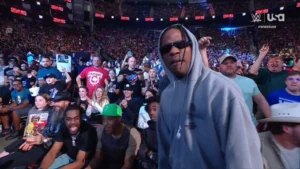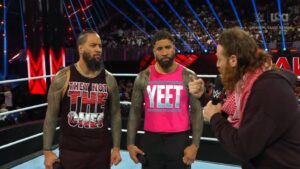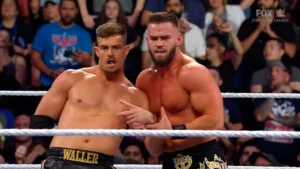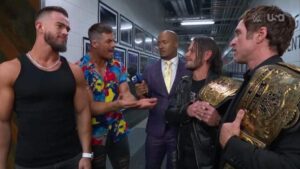While his name has been rightfully tarnished over the past decade, there’s simply no denying the monumental seismic shift in the landscape of pro wrestling that Hulk Hogan created with the rise of Hulkamania in the early 1980s. It originally started in the tail end of his run with the American Wrestling Association (AWA) and was amplified by Vince McMahon Jr. when he brought Hogan back to the WWF in 1983, not to mention his defeat of the Iron Sheik to become WWF World Heavyweight Champion in early 1984. Hulkamania took pro wrestling from a niche peripheral cultural side story and made it part of the zeitgeist of pop culture in the decadence of the most decadent decade of the millennium, the 1980s. When one looks back at Hogan’s astounding level of influence, both in wrestling and pop culture, his greatest rivals often follow – with names like Andre the Giant, Rowdy Roddy Piper, and Randy “Macho Man” Savage at the top of the list. But if you dig a little bit deeper beyond the diatribe of wrestling historians or WWE itself, you will discover that while those three names definitely stand out as some of his biggest profile rivals during his near-decade run at the top of the WWF hierarchy, no one had more televised challenges for his WWF World title than Paul Orndorff, known to most in the WWE Universe at the time as “Mr. Wonderful”.
Orndorff faced Hogan an astounding ten times in televised title matches, making him the man who most challenged Hogan for the World title during his legendary first reign as WWF World Champion that lasted 1,474 days between 1984 and 1988. The closest after that is King Kong Bundy (8), Randy Savage (6), and three men tied at 5 – Big John Studd, Don Muraco, and Kamala. Piper only faced Hogan twice for the WWF World title, the same as Andre (although Andre did defeat him in their rematch). But it was “Mr. Wonderful” Paul Orndorff, the former WWE and WCW Superstar who sadly passed away on July 12 at the age of 71, who would be the most televised opponent for Hogan’s WWF World title during the Rock N’ Wrestling Era of the WWF in the mid-to-late 1980s and the height of Hulkamania.
February 20, 1984: WWF on MSG Network
In August of 1976, WWF began airing a monthly special on the Madison Square Garden (MSG) Network – WWF on MSG Network – and it was on January 23, 1984, on that program that Hulk Hogan defeated Iron Sheik to become the new WWF World Heavyweight Champion. For Hogan’s first televised title defense, it would happen on February 18, 1984, on WWF on PRISM Network against The Masked Superstar (better known to WWE fans as Demolition Ax later in his career), but for his second televised defense (and first on MSG Network since winning the belt), he faced off against “Mr. Wonderful” Paul Orndorff.
Orndorff had debuted in the NWA territories in 1976 (the same year WWF on MSG Network debuted) and had begun to make a name for himself as one of the NWA’s top young stars – he was a budding main eventer in Georgia Championship Wrestling (GCW), where he was a 4x NWA National Heavyweight Champion. But like many rising stars, Orndorff jumped to the WWF exclusively in the early 80s, making his full-time debut in the fall of 1983, roughly the same time as Hogan’s return. Oddly enough, four years earlier, Hogan and Orndorff were allies (and frequent tag team partners) in New Japan Pro-Wrestling (NJPW) during a fall 1980 tour in Japan.
After an impressive televised string of victories, by early 1984, he found himself a manager in Rowdy Roddy Piper and would become part of Piper’s declaration to take out Hulk Hogan alongside another of Piper’s clients, “Dr. D” David Schultz (Piper was still not cleared to compete due to injuries from his legendary dog collar match at NWA Starrcade against Greg “The Hammer” Valentine, and Schultz’s role was eventually phased out, with Piper’s “bodyguard” Cowboy “Ace” Bob Orton Jr. becoming the dominant third man). In February of 1984, Orndorff would be given the first World title shot of the two, when he faced Hogan for the WWF World title on the monthly special on MSG, in a match from New York City’s wrestling mecca, and ultimately Hogan would be declared victorious, although he won by a count-out.
https://www.youtube.com/watch?v=CU_YWJs1OjY
July 7, 1984: WWF on PRISM Network
Similar to WWF on MSG, in 1977 WWF began another regular special called WWF on PRISM Network, with PRISM being the regional cable network based out of Philadelphia, Pennsylvania, and the Philadelphia Spectrum arena. In May, Hogan had his first World title defense on PRISM, the first televised rematch against Iron Sheik, followed by another shot from Sheik in June, but in July, it was Orndorff once again challenging Hogan for the top prize in the WWF. Piper has still yet to face Hogan for the World title and, despite losing clean to Hogan in Philadelphia, Orndorff was now two World title shots over his partner (although Piper would slowly return to the ring from his injuries, initially in tag matches, before challenging Hogan for the first time for the World title in February of 1985, a full year after Orndorff had made his own first challenge).
July 28, 1984: WWF on USA Network
Long before the USA Network became the long-time home for Monday Night Raw, it was first home to a series of specials called WWF on USA Network, which began in 1981. On July 28, 1984, only weeks after their clash on WWF on PRISM Network, Orndorff challenged Hogan once again for his World title. But this time, Orndorff would win the match, after the champion Hulk Hogan was disqualified.
April 27, 1985: WWF on PRISM Network
Coming out of the very first WrestleMania on March 31, 1985, Hulkamania was now a global phenomenon, thanks greatly to the exposure via a partnership with MTV. Roddy Piper’s squad of Orndorff and Orton had failed to vanquish the lights of Hulkamania at the big event but it wasn’t the end of the trios attempts to unseat Hogan at the top. While “The Magnificent” Don Muraco would get the first World title defense on TV following WrestleMania I – on an April 22, 1985 edition of WWF on MSG – it would be Orndorff who once again got the opportunity out of the Piper camp and it happened on April 27, 1985, live from Philadelphia and the Spectrum Auditorium.
Once again, the power of Hulkamania would prove to be too powerful and Orndorff would leave the ring without the WWF gold. Soon after, Piper and Orton turned on Orndorff, effectively turning Orndorff face for the first time in WWF, and soon “Mr. Wonderful” began tag-teaming with his former NJPW partner in battles against Piper and Orton, as well as others, in an alliance that lasted until the summer of 1986.
August 28, 1986: WWF The Big Event
By the end of June, Orndorff was starting to get mocked by the heels in the company as being soft since allying with Hogan – often calling him “Hulk Jr.” – and after a miscommunication with Hogan in a televised tag match against Big John Studd and King Kong Bundy, Orndorff refused to help his partner from a brutal double team and then delivered his patented piledriver to Hogan post-match. The pre-Mega Powers had exploded, and once again, Paul Orndorff was putting Hulk Hogan in his sights.
Now under the managerial prowess of historically Hogan-obsessed Bobby “The Brain” Heenan, Orndorff became the #1 contender for Hogan’s WWF World Heavyweight Championship and was about to become his highest drawing opponent to date. On August 28, 1986, at Exhibition Stadium in Toronto, Ontario, WWF held WWF The Big Event, which saw Hogan and Orndorff battle for the WWF World title in front of 61,000+ fans, at the time, WWF’s largest drawing event. Despite help from “The Weasel”, Orndorff once again fell short in his quest to dethrone the Hulkster. While not aired live, it was later packaged as a special VHS later that year.
September 13, 1986: WWF Saturday Night’s Main Event
While not televised, Orndorff once again main-evented a huge WWF special event in the 1986 Sam Muchnick Memorial Tournament, held August 29, 1986 at the Kiel Auditorium in St. Louis, Missouri. Muchnick had been one of the founding fathers of the National Wrestling Alliance (NWA) in 1948, and his St. Louis territory was one of the most influential and important territories in the NWA’s history, but in 1983, a year after his retirement, he sold the territorial and TV time slot to McMahon’s rising WWF (although his actual promotion, St. Louis Wrestling Club, was sold to Jim Crockett in 1985 and merged with what became WCW).
But at the huge event – which saw longtime St. Louis legend and 8x NWA World’s Heavyweight Champion Harley Race defeat Ricky Steamboat in the finals of the tournament – Orndorff once again lost to Hogan in the main event. He continued to be Hogan’s top adversary, and on the seventh edition of WWF’s new special, WWF Saturday Night’s Main Event on NBC, live from Richfield, Ohio, Orndorff once again fought Hogan for the World title, again losing by DQ.
September 20, 1986: WWF on PRISM Network
By this point, Orndorff was now Hogan’s primary challenger on most WWF house shows, and on September 20, he returned to the Philadelphia Spectrum and PRISM to once again challenge the forces of Hulkamania in his continued quest to be the WWF World Champion. Once again, Hulkamania prevailed.
October 18, 1986: WWF on PRISM Network
A month later, Orndorff challenged Hogan once again, but Hogan failed to pin Paul Orndorff in the ring, retaining his title via count-out.
December 13, 1986: WWF on PRISM Network
By December, Orndorff and Hogan’s feud had become far more than a simple pissing contest – it had grown personal and emotional. Once again on PRISM and at The Spectrum, the two collided, but this time, it was inside the confines of a steel cage. Ultimately, it was a dress rehearsal for the following night’s contest on WWF Saturday Night’s Main Event, but for fans on the East Coast, they were treated to another televised battle – the 9th – between “Mr. Wonderful” and the Hulkster.
December 14, 1986: WWF Saturday Night’s Main Event
The 10th and final encounter televised in Orndorff and Hogan’s two-year feud over the WWF World title happened once again in a steel cage like the previous night in Philadelphia, only this time the match went down in Hartford, Connecticut, in another classic encounter, with sadly, another Hogan victory. By the end of the year, Hogan and Orndorff were once again allies, and in early 1988, Orndorff retired from pro wrestling due to an arm injury.
In 1990, he would make a comeback, but signed with World Championship Wrestling instead of returning to WWF. It was short-lived, but he returned again in 1992, capturing the WCW World Television title and WCW World Tag Team titles with Paul Roma, before ultimately retiring in 1995. He remained a trainer in WCW and in 2005, was inducted into the WWE Hall of Fame.
While his feuds with Piper and Andre particularly are synonymous with Hogan’s first epic title reign as WWF World Champion, it was ultimately Paul Orndorff who was Hogan’s greatest threat during his three-year reign from 1984 to 1988. And his enemy to a friend to betrayal storyline was an early blueprint for the Mega Powers storyline that would encapsulate Randy Savage’s first WWF World title reign as well as Hogan’s second. If not for his serious injury that not only forced his WWF career to end, but also hindered his two WCW comebacks, there’s not telling what history would have written for the man that was known simply as “Mr. Wonderful”.
Stay tuned to the Last Word on Pro Wrestling for more on this and other stories from around the world of wrestling, as they develop. You can always count on LWOPW to be on top of the major news in the wrestling world, as well as to provide you with analysis, previews, videos, interviews, and editorials on the wrestling world. You can check out an almost unlimited array of WWE content on the WWE Network and Peacock.
Looking to talk wrestling, pro football, or any number of sports? Head on over to the LWOS Boards to engage in conversation with fellow fans!






